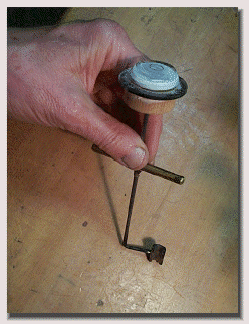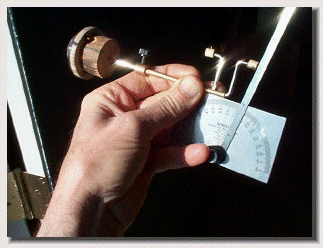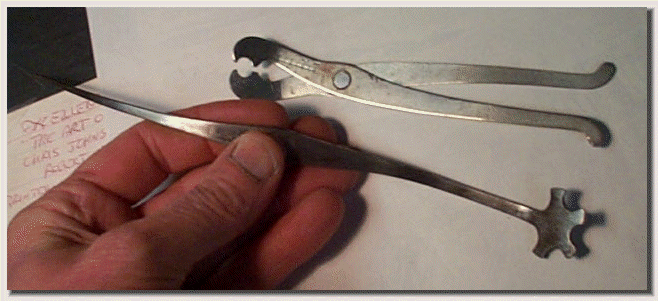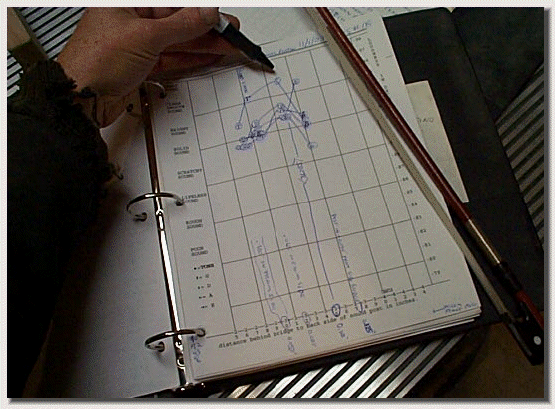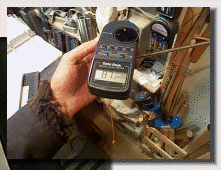Sound Post Adjustment for best performance...
...The general guide for sound post placement for full sized violins is that the near (front) side of the sound post should be 1/8" { 1/2 the diameter of the sound post} behind the back side of the bridge and centered on the right foot of the bridge, or perhaps slightly outboard from this position, but inside the outside border of the right hand bridge foot.
...
...I believe that the entire range of adjustment is in that +/- 0.005" range from the 1/8" standard. See test chart below to see actual test results showing how loudness and tone changes with slight movements of the sound post.
... Along with the relative position to the bridge, the post should be vertical and both ends should closely match the angle of the plate at the contact point.
...Before you move the sound post I recommend that you use a fixture to hold the violin horizontal and which firmly clamps the instrument down so both of your hands are free. It is a very good idea to lessen the string tension to say only 1/4 of normal tension to lessen the pressure on the sound post so that it can be moved easier and to prevent damage to the wood at the contact point, especially to the soft wood of the spruce top plate.
...I use the special flat sound post pliers to move the top of the sound post and a sound post tool to move the bottom end of the 'post. Normally I move the top end of the sound post first until it is in the position I want, and then increase the string tension to about 1/2 tension and then move the bottom end of the post until it is exactly perpendicular (to the plane of the back plate's perimeter edges).
... When I make a sound post, I draw on an arrow in ink showing 'up' and facing the right side of the instrument; that way, at a glance I can see which end of the sound post should be up and be sure that the post has not turned.
...The grain lines of the sound post should be oriented from side to side, that is perpendicular to the grain of the top plate.
...The sound post needs to be a certain length within +/-0.002" of the ideal length. When in position and with no string tension, the sound post should stand in position without falling when the violin is gently tipped. It is the string tension that really clamps the sound post into position. You may want to rub a bit of white blackboard chalk onto the ends of the sound post to help it keep it's position, when installing a new sound post.
...As a practical length, I suggest that you add 0.010" to the ideal centerline length when making your new sound post. This will add a slight preload and make it less likely to shift or fall out of position.
..If the violin has been apart, another new bridge might be required after the violin has reached equalibrium again, in a few weeks of playing.

...Here I am measuring the bottom end angle for a new sound post. The angle protractor measurements are written down for future reference. The center-line length of the sound post is also measured at this time.
... Notice that this tool has small wood sound post material epoxied to the ends of a commercially available tool. These fit looselyto begin with and the epoxy mixtured holds them on while inserting through the sound holes and raising into position; then the epoxy sets up with the ends in position, at the correct end angles, in the violin being measured. No guessing anymore!
... Once the sound post top end is installed and put into position, this tool allows measuring to see if the sound post is vertical. The bottom has a cup shape that nestles against the sound post, at which time the top mounted bubble balance is checked for level. You can then see which way the bottom of the sound post needs to be moved in order for the post to become vertical.
...It must be remembered that in all operations involving moving the sound post, no tool must ever come in contact with the wood of the violin around the sound holes. The spruce is very fragile all around the sound hole opening and because cross grain wood this thin can be easily broken off, it must not be touched... thus the importantance of having both hands free to manilupulate the special tools and a fixture that firmly holds the violin in place.
This special flat sound post pliers is good for moving the top of the sound post...
... A traditional sound post tool; one end is for piercing and holding the sound post while it is inserted through the right side sound hole and moved into initial position, while the other end is used for moving the bottom of the sound post in different directions. It can be inserted through either sound hole. Remember that neither of these tools must ever touch the wood of the violin....
...Sound meter is held in position ( by the pictured metal rod) 14" from the violin's bridge while maximum loudness of the violin's bowed open strings is recorded on chart (as pictured in photo to the left).
...The bottom chart units are in inches behind the bridge back to the back side of the sound post (in hundredths of an inch). The right side chart units are DB of loudness recorded from the sound meter; each 10 DB is double the sound loudness. This chart is typical for a full sized violin. Notice that the maximum loudness increases about 30% when the ideal sound post position is used (and all strings reach a peak at the same point as the tone is maximized (tone impression line is being pointed to with the pen). Once this point is determined and recorded, it becomes the permanent ideal sound post location and need not be concerned about in the future.
...Also note that a change in positon of only +/- 0.020" will be a loss of between 20 and 30% of the total possible power and tone quality. The sound post position is not an arbitrary setting but one that the instrument insists on for proper playing.
...When doing the above test, the sound post must be moved (after first re-installing the the holding fixture and lessing the string tension) , then the sound post made exactly vertical again in its new position, and then the string tension brought up to concert pitch, bridge straightened up and the maximum loudness bowing test repeated for the next data point. Thus this test can easily consume an hour of time to do properly, but the results are valuable!
(modified 9/2017)
Page AA_06


